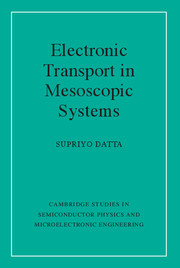Book contents
- Frontmatter
- Contents
- Acknowledgements
- A few common symbols
- Introductory remarks
- 1 Preliminary concepts
- 2 Conductance from transmission
- 3 Transmission function, S-matrix and Green's functions
- 4 Quantum Hall effect
- 5 Localization and fluctuations
- 6 Double-barrier tunneling
- 7 Optical analogies
- 8 Non-equilibrium Green's function formalism
- Concluding remarks
- Solutions to exercises
- Index
8 - Non-equilibrium Green's function formalism
Published online by Cambridge University Press: 05 June 2013
- Frontmatter
- Contents
- Acknowledgements
- A few common symbols
- Introductory remarks
- 1 Preliminary concepts
- 2 Conductance from transmission
- 3 Transmission function, S-matrix and Green's functions
- 4 Quantum Hall effect
- 5 Localization and fluctuations
- 6 Double-barrier tunneling
- 7 Optical analogies
- 8 Non-equilibrium Green's function formalism
- Concluding remarks
- Solutions to exercises
- Index
Summary
So far in this book we have described the effect of electron–phonon or electron–electron interactions in phenomenological terms, through a phase-relaxation time. In this chapter we will describe the non-equilibrium Green's function (NEGF) formalism which provides a microscopic theory for quantum transport including interactions. We will introduce this formalism using simple kinetic arguments based on a one-particle picture that are only slightly more difficult than those used to derive semiclassical transport theories like the Boltzmann equation. This heuristic description is not intended as a substitute for the rigorous descriptions available in the literature [8.1–8.8]. Our intention is simply to make the formalism accessible to readers unfamiliar with the language of second quantization. We will restrict our discussion to steady-state transport as we have done throughout this book.
The NEGF formalism (sometimes referred to as the Keldysh formalism) requires a number of new concepts like correlation functions which we introduce in Sections 8.1 and 8.2. We then describe the formalism in Sections 8.3–8.6. In Section 8.7 we relate it to the Landauer–Büttiker formalism which, as we have seen, has been very successful in describing mesoscopic phenomena. For non-interacting transport the two are equivalent, and the added conceptual complexity of the NEGF formalism is not necessary. The real power of this formalism lies in providing a general approach for describing quantum transport in the presence of interactions.
- Type
- Chapter
- Information
- Electronic Transport in Mesoscopic Systems , pp. 293 - 342Publisher: Cambridge University PressPrint publication year: 1995
- 9
- Cited by



